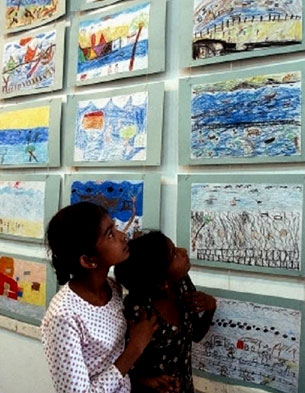

 ONE YEAR ON: A year has passed since the Indian Ocean Tsunami struck many counties around the Indian Ocean and killing up to 230,000 people. Since then, knowledge about the relationships between the plate boundaries in this part of the world has moved on apace and just a few weeks before a second large earthquake (8.7Mw) rocked the region again in March 2005 this was predicted by modelling of Coloumb stress change along the still locked parts of the fault. What was not precicted, however was the exact time and place - only the area where the most stress had been placed on the fault. When the earthquake stuck, widespread panic set as people had learned that a large earthquake could be connected to another tsunami. People headed inland as fast a they could. The tsunami that followed was much smaller, with runups of 3 metres being the largest recorded. Nevertheless the earthquake uplifted land by 1metre in some places and cuased subsidence of 1m in other places. 1000 people lost their lives as buildings fell and there were many injuries.
ONE YEAR ON: A year has passed since the Indian Ocean Tsunami struck many counties around the Indian Ocean and killing up to 230,000 people. Since then, knowledge about the relationships between the plate boundaries in this part of the world has moved on apace and just a few weeks before a second large earthquake (8.7Mw) rocked the region again in March 2005 this was predicted by modelling of Coloumb stress change along the still locked parts of the fault. What was not precicted, however was the exact time and place - only the area where the most stress had been placed on the fault. When the earthquake stuck, widespread panic set as people had learned that a large earthquake could be connected to another tsunami. People headed inland as fast a they could. The tsunami that followed was much smaller, with runups of 3 metres being the largest recorded. Nevertheless the earthquake uplifted land by 1metre in some places and cuased subsidence of 1m in other places. 1000 people lost their lives as buildings fell and there were many injuries.
What is certain is that a large earthquake will occur in this region again. There is at present, no certainty as to when and scientists can only really talk about probabilities of earthquakes on certain 'locked' parts of the faults suddenly slipping and an earthquake occuring.
The best way of avoiding the very large loss of life and injury is education coupled with scientific knowledge and hazard mitigation. This mini website deals with the education by using animations, movies and maps and images, the science behind earthquakes and tsunamis can be better understod and that this will lead to better hazard preparedness in the far flung corners of the world. Justin Sharpe, geography teacher, Beal High School.

Free Site Counters